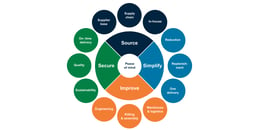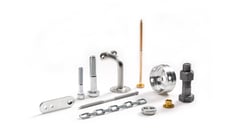Att satsa på ökad hållbarhet för att uppnå framgång blir alltmer avgörande i dagens affärsmiljö. Tillverkande företag som ditt står inför påtryckningar från regeringar, ägare, aktieägare och kunder att göra sin värdekedja mer hållbar från början till slut. Företag som tidigare behövde hantera komplexa produktionsprocesser och globala leveranskedjor måste nu analysera hur de påverkar miljön och utveckla konkreta planer för att minska denna påverkan så mycket som möjligt.
Denna press kommer bara att öka när regelverket förändras och hållbarhet får en högre prioritet på agendan. Det innebär att tillverkare som precis har påbörjat sin hållbarhetsresa måste ta ikapp.
Bultar, muttrar, skruvar och alla andra småprodukter som utgör ditt lager av C-parts kan verka som en liten del av din verksamhet, men de spelar ändå en viktig roll för hållbarheten. Leveranskedjorna för C-parts har potential att avgöra din företags övergripande hållbarhetsresa, precis som leveranskedjorna för dina andra kategorier av produkter. Ingen vill att en journalist ska ställa frågor om barnarbete i er leverantörskedja. Som inköpare är dina beslut avgörande för att minska negativa effekter och säkerställa att du uppfyller ditt företags hållbarhetsmål.
I den här guiden sammanfattar vi de viktigaste kunskaperna du behöver ha om hållbarhet i leverantörskedjan för C-parts - från en grundläggande förklaring av vad hållbarhet i leverantörskedjan innebär till konkreta åtgärder som kan förbättra hållbarheten för dina C-parts. Använd länkarna i varje kapitel för att lära dig mer om varje ämne i mer detalj och ladda ner guiden till hållbarhetstrender för C-parts för att förstå hur företag som ditt anpassar sig.
Chapters
Chapters
Vad innebär hållbarhet inom leveranskedjan för C-parts?
För att förstå vad hållbarhet inom leveranskedjan innebär och hur det relaterar till C-parts, kan vi börja med definitionen av hållbarhet. Redan 1987 definierade FN detta enligt följande:
Mänskligheten har förmågan att göra utveckling hållbar för att säkerställa att den tillgodoser behoven hos dagens generation utan att kompromissa med framtida generationers förmåga att tillgodose sina behov..
I korthet är hållbarhet ett sätt att tänka som säkerställer att mänskliga aktiviteter som skapar tillväxt och utveckling kan fortsätta långt in i framtiden. Det handlar inte om att begränsa prestationer eller framgång, utan snarare om att se till att framtida generationer också kan dra nytta av dessa framsteg. Detta uppnås genom att använda jordens resurser på ett klokt sätt, minska utsläpp för att skydda miljön och fatta långsiktiga affärsbeslut som gynnar både samhället och ekonomin.
I ert företags hållbarhetsarbete brukar hållbarhet delas in i tre huvudkategorier:
- Miljömässig hållbarhet – Detta är ofta det första många tänker på när det gäller hållbarhet. Det handlar om att bevara naturresurser, minimera koldioxidutsläpp och ha så liten påverkan på miljön som möjligt.
- Social hållbarhet – Denna kategori fokuserar på företagets påverkan på människor, inklusive anställda längs värdekedjan, kunder, lokala samhällen och samhället i stort.
- Ekonomisk hållbarhet – Detta avser affärsmetoder som har en positiv effekt på den bredare ekonomin, anställda och leverantörer samt skapar förutsättningar för långsiktig tillväxt.
Med detta som bakgrund kan hållbarhet inom leveranskedjan definieras som:
Processen att bygga en optimerad leveranskedja som minimerar dess negativa miljömässiga, sociala och ekonomiska påverkan samt stärker dess positiva effekter.Varje steg i en leveranskedja behöver vara hållbart – från utvinning av råmaterial till distribution av färdiga produkter och hantering vid slutet av produktens livscykel.
Samtidigt är moderna leveranskedjor komplexa och omfattande system. Leveranskedjor för C-parts är särskilt fragmenterade och saknar ofta konsolidering. Därför ser många av de företag som deltar i FN
Global Compact – en global grupp organisationer som arbetar för hållbarhet – leveranskedjan som den största utmaningen för att förbättra sin hållbarhetsprestanda.
Varför är hållbarhet inom leveranskedjan viktigt?
Tidigare har hållbarhet ofta betraktats som en ”trevlig bonus” som förbättrar ett företags image. Men det blir allt tydligare att hållbarhet är en avgörande faktor för ett företags framgång. Här är tre faktorer att överväga för att förstå varför det är värt att lägga tid och resurser på att förbättra hållbarheten i C-parts leveranskedjor::
Miljömässiga fördelar
När du idag köper konsumentvaror ser du ofta företag som lyfter fram återvunna och miljövänliga material i sina produkter. Det är en positiv utveckling, men för tillverkningsföretag är det största miljöavtrycket inte knutet till den slutliga produktionen, utan till deras leveranskedjor. Enligt en rapport från McKinsey (2016) genereras cirka 80 % av ett genomsnittligt företags totala utsläpp av växthusgaser inom leveranskedjan. Dessutom står leveranskedjan för mer än 90 % av den totala påverkan på ”naturkapital” – jordens resurser som mineraler, jordar, vatten och luft.
Om ert företag vill förbättra sitt hållbarhetsarbete behöver ni se på hela produktens livscykel, från design till slutlig hantering. Under produktutvecklingen måste hela leveranskedjan utvärderas och välgenomtänkta beslut fattas. Val som verkar optimala idag kan snabbt överträffas av nya möjligheter i framtiden. För att optimera och bibehålla hållbarhet krävs djupgående kunskap om alla delar av leveranskedjan, eller samarbete med pålitliga partners som kan bistå med detta.
När det gäller exempelvis fästelement behöver ni tänka på mer än bara produktens funktion, kvalitet och hållbarhet. Ni måste även överväga hur produkten och fästelementet kan återvinnas eller återanvändas. Ett exempel är att välja ett fästelement i ett material som kan smältas tillsammans med det material det fäster vid. Liknande överväganden måste göras för alla delar av en slutprodukt.
Det är också värt att notera att de största förändringarna för befintliga produkter ofta kan göras inom leveranskedjan.
Nya regleringar inom hållbarhet
Många nationella och internationella regleringar har redan införts för att förhindra företag från att bedriva ohållbara verksamheter. Under andra halvan av 1900-talet kom en våg av lagar som syftade till att hindra företag från att förorena miljön genom sina tillverkningsprocesser eller produkter.
Dessa regler har funnits länge, men under 2020-talet ser vi allt fler nya lagar och regler som ökar kostnaderna – både operativa och finansiella – för företag som agerar ohållbart. Ett exempel är EU
Corporate Sustainability Reporting Directive (CSRD). Från och med 2024 måste stora företag börja rapportera om sitt hållbarhetsarbete på samma sätt som de rapporterar sina finanser idag. Import av varor från Fjärran Östern kommer också att bli svårare i takt med att nya utsläppsregler och antidumpningslagar införs.
Fler regleringar kommer att följa, och deras effekter kommer att göra hållbarhetsarbete avgörande för att driva ett framgångsrikt företag. Många företag kommer att vara oförberedda för dessa förändringar, men de som förbereder sig och är redo kommer att ha en konkurrensfördel.
Mer information om kommande regleringar och deras påverkan på din verksamhet finns i artikeln: Sustainable C-Parts: What You Need to Know.
Marknadens krav
Regleringar är en av de drivkrafter som pressar tillverkare mot hållbarhet, men marknadens krav är minst lika starka. Hållbarhet blir en allt viktigare faktor för konsumenter när de gör sina köpbeslut, och många företag svarar redan på detta. Företag som tillverkar konsumentvaror möter idag kunder med höga krav på produkternas hållbarhet – och snart även på de affärsmetoder som används i produktionen.
Inom en snar framtid kommer en hållbar leveranskedja och ett tydligt engagemang för hållbarhet att vara en förutsättning för företag som vill attrahera nya kunder.
Vilken roll spelar C-parts i hållbarheten inom leveranskedjan?
I en leveranskedja är alla delar viktiga – från den minsta skruven till den mest kraftfulla motorn. Varje del har sin egen komplexa leveranskedja, och det krävs information om alla delar för att uppfylla kommande regelverk och förbättra hållbarheten.
C-parts får ofta inte den uppmärksamhet de förtjänar i tillverkningsföretag och betraktas ibland som en eftertanke jämfört med andra typer av delar. Även om en enskild del kan verka obetydlig, är det totala lagret av C-parts en betydande bidragande faktor till företagets utsläpp och övergripande miljöpåverkan.
Ta till exempel en enda bult i stål. För att tillverka den måste råmaterial utvinnas och transporteras till ett stålverk, där de omvandlas till stål i en energikrävande process. Stålet transporteras sedan till en bulttillverkare, som använder stora mängder energi för att omvandla stålet till bultar. Därefter kontrolleras, förpackas och skickas bultarna för leverans, transporteras långa avstånd till slutanvändaren, packas upp, lagras och används till sist i en produkt. Även när produkten är färdig måste den transporteras till en slutanvändare och används tills den slutligen återvinns eller kasseras.
Om du analyserar de komplexa processerna bakom dina C-parts inser du hur mycket utsläpp och arbete som krävs för att få dem levererade. I varje steg i processen finns det möjligheter att förbättra hållbarheten – oavsett om det handlar om utvinning av råmaterial, tillverkning av produkten, transport och frakt, eller arbetsförhållandena för de som är involverade.
När du multiplicerar denna process över alla dina C-parts och leverantörer blir det tydligt vilken påverkan dessa mindre delar har på den totala miljöpåverkan som ditt företags verksamhet skapar.
Utmaningar för hållbarhet i leveranskedjan och C-parts
C-parts skapar specifika hållbarhetsutmaningar i leveranskedjan som du troligtvis känner till. I vårt arbete med kunder identifierar vi vanligtvis tre huvudsakliga utmaningar kopplade till C-parts som har en oproportionerlig påverkan på leveranskedjans hållbarhet:
- Okoordinerade leverantörsbaser
- Höga minimiorderkvantiteter (MOQ)
- Utmaningar i lagerhantering
Okoordinerade leverantörsbaser
C-parts är små, billiga och till synes oviktiga komponenter. Detta är en av anledningarna till att många tillverkare inte har investerat tid och resurser i att konsolidera sina leverantörsbaser för denna kategori, till skillnad från deras dyrare, större och mer synliga komponenter. Detta gäller förvånansvärt ofta, trots att den samlade påverkan från alla C-parts i alla produkter kan ha en betydande effekt på företagets klimatavtryck.
Resultatet är att stora tillverkare ofta har tiotals eller till och med hundratals individuella leverantörer av C-parts. Varje leverantör har sitt eget fakturerings- och ordersystem, vilket är utmanande för inköpare, och var och en har dessutom sin egen produktionsanläggning, tillverkningsmetoder och fraktprocesser. Att fylla på med några olika delar kan därför innebära flera internationella transporter och lastbilsleveranser av de nödvändiga delarna till fabriken. Detta ineffektiva och okoordinerade tillvägagångssätt genererar betydligt fler utsläpp än om en enda leverantör skickade alla delar i en samlad leverans direkt till fabriken.
C-parts leverantörsbaser är generellt sett mycket mindre konsoliderade än andra kategorier av delar, vilket gör det avgörande att beakta detta vid utvärdering och förbättring av leveranskedjan.
Höga minimiorderkvantiteter (MOQ)
Tillverkare som arbetar direkt med leverantörer av C-parts stöter ofta på problem med höga minimiorderkvantiteter (MOQ). Om en tillverkare behöver 1 000 stycken av en viss del, men leverantörens MOQ är 2 000, kan tillverkaren tvingas beställa det större antalet. Detta ökar kostnaderna, tar upp plats i lagret och ökar risken för att delarna blir överflödiga. Om produkten de används i tas ur produktion, eller om en förbättrad design introduceras, kan dessa delar bli oanvändbara – vilket leder till ett överskott som måste kasseras eller återvinnas. Materialet och energin som används för att tillverka och transportera dessa delar har då slösats bort, vilket ökar företagets miljöpåverkan i onödan.
Höga MOQ är vanligare för C-parts än för andra delar, vilket skapar en utmaning som påverkar leveranskedjans hållbarhet. Som tillverkare är det viktigt att ha en dialog med leveranskedjan för att undvika överproduktion, spill och onödig miljöpåverkan.
Utmaningar i lagerhantering
C-parts lager kännetecknas av stora mängder delar och stor variation. En biltillverkare kan till exempel bara använda tre eller fyra typer av dörrpaneler i sina fordon, men hundratals olika typer av fästelement. Denna variation, i kombination med uppfattningen att det inte är värt att investera tid och pengar i att effektivisera hanteringen av C-parts, leder ofta till att tillverkare har en otillräcklig överblick över sitt lager av C-parts.
I praktiken kan detta resultera i brist på nödvändiga delar, som ofta upptäcks för sent. I dessa situationer har tillverkaren två val: stoppa produktionen eller beställa en expressleverans av de nödvändiga delarna. På grund av de höga kostnaderna för stillestånd är expressleverans ofta det bästa valet, men det sker till priset av ineffektivitet och höga utsläpp, särskilt om delarna transporteras med flyg.
Lager av A- och B-parts hanteras vanligtvis mer effektivt, vilket innebär att de sällan bidrar till samma hållbarhetsproblem som C-parts lätt kan orsaka.
Du kan läsa mer om andra hållbarhetsutmaningar kring C-parts och hur de kan lösas i artikeln: Sustainability Challenges with C-Parts and How to Solve Them
Hur du förbättrar hållbarheten i din C-parts leveranskedja
Att utvärdera en befintlig leveranskedja och vidta konkreta åtgärder för att förbättra dess hållbarhet är en betydande uppgift som alla företag måste hantera under de kommande åren. Det finns ingen enskild åtgärd som kan sammanfatta det arbete som behöver göras. Istället krävs en gemensam insats från teammedlemmar inom inköp, produktion, planering, FoU, logistik och ledning för att säkerställa att leveranskedjan följer regler och minimerar risker. Följande tre steg är avgörande för företag som insett vikten av hållbarhet och som vill transformera sina C-parts leveranskedjor:
Utveckla en hållbarhetspolicy
En hållbarhetspolicy ger en stabil grund för det praktiska hållbarhetsarbetet. För att optimera något så komplext som en C-parts leveranskedja krävs flera avdelningar och kompetenser. En hållbarhetspolicy samlar organisationen kring en gemensam vision och skapar en ram för arbetet. När policyn tas fram av rätt personer och accepteras av företagsledningen säkerställs att företagets insatser fokuseras på rätt områden.
Mer insikt om hur en hållbarhetspolicy kan se ut och hur andra företag har skapat dem finns i artikeln: How to Fulfil Your Sustainability Policy in C-Parts Purchasing.
Sätt upp KPIer
Hållbarhetspolicyn är grunden för hållbarhetsarbetet i leveranskedjan, men dess syfte är att ge en bred vision. För att mäta prestation och måluppfyllelse i varje avdelning behövs nyckeltal (KPIer). Dessa KPIer varierar beroende på företagets och branschens natur, men typiska hållbarhetsrelaterade KPI inkluderar:
-
Utsläpp genererade av företagets verksamhet – Detta är troligen det övergripande KPI som allt hållbarhetsarbete relateras till. Det bör inkludera scope 1- och 2-utsläpp, exempelvis utsläpp från företagets fordon eller elproduktion för kontor. Scope 3-utsläpp, som genereras indirekt i leveranskedjan och distributionsnätverket, är också viktiga men svårare att definiera.
-
Antalet leverantörer – Detta KPI ligger ofta på inköpsavdelningen. Varje C-parts leverantör har egna produktions- och fraktmetoder. Genom att konsolidera leverantörer kan antalet transporter minskas – och därmed även utsläppen i leveranskedjan. Detta är särskilt relevant för europeiska tillverkare som köper delar från Asien.
-
Antalet expressleveranser – Planering, produktion och inköp måste samarbeta för att minimera behovet av expressleveranser. Dessa är ofta nödvändiga men ineffektiva och orsakar höga utsläpp, särskilt vid flygfrakt. Förbättrad kommunikation och implementering av lösningar som VMI kan minska risken för brist på delar.
Mer information om relevanta KPI och mål för hållbara C-parts inköp finns i artikeln: Sustainability Targets and KPIs to Implement in the Purchasing Office.
Arbeta med hållbar upphandling
KPIer ovan fokuserar främst på utsläpp, en viktig del av det större sammanhanget. Men miljömässig, social och ekonomisk hållbarhet möjliggörs också genom rätt upphandlingspraxis. Detta innebär att välja leverantörer baserat på sociala kriterier, som arbetsförhållanden, avtal och juridisk efterlevnad. Miljöfaktorer, såsom leverantörens avfallshantering och energianvändning, är också viktiga. När det gäller ekonomisk hållbarhet handlar det om att hitta seriösa leverantörer att bygga långsiktiga relationer med, vilket i förlängningen underlättar andra hållbarhetsmål.
Priset är alltid en viktig faktor, men att säkerställa att leverantörerna delar ert engagemang för hållbarhet och bidrar till detta arbete kommer att ge större fördelar på lång sikt.
Om du vill veta mer om hållbar upphandling kan du läsa artikeln: Vad är hållbar upphandling?
Hämta guiden om hållbara upphandlingstrender som påverkar dig
Vi hoppas att den här guiden har gett dig insikter i vikten och komplexiteten kring hållbarhet i leveranskedjan för C-parts. För att lära dig mer om de hållbarhetskrav som kommer att påverka dig i framtiden och hur du kan förbereda dig för dem, se till att ladda ner vår kostnadsfria guide nedan – "Tillverkarens guide till hållbara upphandlingstrender"










